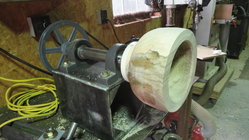For those who do not know about Joan's death, here is a summary by her husband Ernest Kelly.
"Many of you are already aware of Joan's dreadful accident on May 4, 2011, but I will give a brief account: Joan was turning a heavy bowl blank on her lathe. It flew to pieces and one large piece struck her in the face and forehead causing profuse bleeding and underlying injuries to the face and skull. I found her within what must have been a very few minutes, called an ambulance, and applied a compress. She got to the hospital having lost a great deal of blood and requiring transfusions. She immediately went into surgery. Over the last ten days, her blood pressure and other vital signs have generally stabilized. We hope that the swelling is decreasing, and Tuesday a lumbar puncture lowered the pressure on the brain dramatically. We pray for a good recovery, but she has not yet regained consciousness. She is receiving outstanding medical care."
A few days later, Skip Wilbur (President of MSWG at that time) had to write the following:
"It is with great sadness I report that our dear friend and club member Joan Kelly went to eternal life today. The injury Joan sustained two weeks ago was too much for her body to overcome. Please keep her family in your prayers, they have been through a lot. There will be a memorial service Saturday morning at 11:00 at Balmoral Presbyterian Church."
Lathe Guarding vs Face Shield
Largest Duck Call and Lathe Guard
Read more about Joan Kelly in this book.

"Many of you are already aware of Joan's dreadful accident on May 4, 2011, but I will give a brief account: Joan was turning a heavy bowl blank on her lathe. It flew to pieces and one large piece struck her in the face and forehead causing profuse bleeding and underlying injuries to the face and skull. I found her within what must have been a very few minutes, called an ambulance, and applied a compress. She got to the hospital having lost a great deal of blood and requiring transfusions. She immediately went into surgery. Over the last ten days, her blood pressure and other vital signs have generally stabilized. We hope that the swelling is decreasing, and Tuesday a lumbar puncture lowered the pressure on the brain dramatically. We pray for a good recovery, but she has not yet regained consciousness. She is receiving outstanding medical care."
A few days later, Skip Wilbur (President of MSWG at that time) had to write the following:
"It is with great sadness I report that our dear friend and club member Joan Kelly went to eternal life today. The injury Joan sustained two weeks ago was too much for her body to overcome. Please keep her family in your prayers, they have been through a lot. There will be a memorial service Saturday morning at 11:00 at Balmoral Presbyterian Church."
Lathe Guarding vs Face Shield
Largest Duck Call and Lathe Guard
Read more about Joan Kelly in this book.


